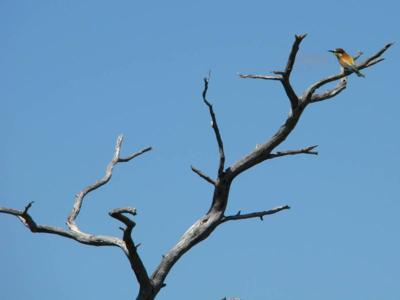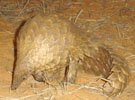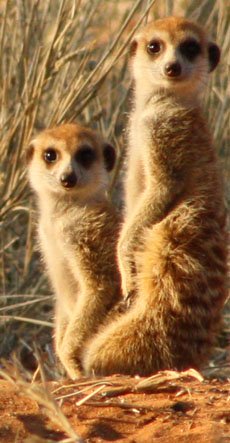For more information about our hunting safaris, don’t hesitate to reach out and contact us!
Birds of Namibia
by Enrique del Rosario
(Beaverton, Oregon, USA)
"Yes, and you?"
"We are. Bellevue, Washington. Where are you from?" asked the one blonder than the other.
"My son and I are from Portland. John, here, is from Boise, and Tim is from Kalispell."
"Wow, what a small world. We're practically neighbors. What brings you to Africa? Vacation?"
"Hunting."
"Oh."
"Oh?" Did I detect disapproval? "And you, what brings you to Africa?"
"Birds."
"Birds? Ornithologists, huh?"
"Well kinda, but not really. We're biology majors at the University of Washington. We just enjoy watching birds."
"Something I like doing too."
------
The rainy season is coming to an end and soon the streets of Swakopmund would be teeming with people seeking respite from the higher temperatures of the inland.
European Bee-eaters feast on the dragonflies and mantises, preparing for their annual migration over the velds and savannahs and deserts and mountains of Africa to nest in the steeples of Tuscan basillicas, or along the Ruhr, or even further north to the slopes of the Urals.
------
"So what do you hunt?" "So what birds have you seen?"
"Sorry, you first," I apologized.
"No, please. I mean, what do you hunt?"
"This time I'll be after Zebra. John's after Kudu, and Gemsbok."
"Oh. What do you do with them, I mean, after...after..."
"After I shoot them? Except for the hide and horns, I eat them."
"Eat them?"
"Yes."
"Isn't that...uh, a lot of meat? I mean, isn't that a waste?"
"But I share the meat with the locals. Impolite not to. In fact, they get the greater part of the meat. Why, you a vegetarian?"
"No, it's just...I mean, you really eat zebra?"
"Yes, and Kudu, and Oryx, and Springbok, and...you mean you haven't had any of the game meat here in Namibia? Delicious, you don't know what you're missing."
------
Almost motionless, riding the Benguela winds, a Cape Gannet hovers. In an instance it plunges straight down into the cold Atlantic and just as quickly rises, its beak holding captive a small sardine.
The waitress brings to the tourist women steaks trimmed with vegetables, sides of bread, and salad. The Baster girl, white-aproned, smiles and awaits her customers' approval.
------
"Thank you, er....excuse me, Miss. What kind of meat is this?", asked the blonder of the two.
"Steak, ma'am. Is it as you like? Is it cooked enough?"
"No, I mean yes. I ordered it medium well. But what kind of meat is this, you know, I mean what animal?"
"Cow, ma'am." out of the girl's uneasy English vocabulary.
"She means beef. Don't worry. It's not Zebra." I said, hoping to clarify and assist.
They examine their steaks carefully, suspiciously. After a few small bites the two decide that they have eaten enough and must watch their diet.
"So, tell me, what birds have you seen here in Namibia?"
"Nothing yet. We just got here, I mean, from Windhoek. Spent last night there." said the one in light blue shorts.
"So you're going to start your bird watching here in Swakopmund?"
"Well, sort of. We'll rest for a few days. Maybe head down to Walvis Bay to see the flamingoes. Have you been there?"
"Yes. You'll find them in the lagoon, along with cormorants, sandpipers, gulls, and pelicans."
"Cool. And what about inland?"
"Depends on where you're going."
"We don't know. You seem to know your way around. Where would you suggest?"
"Well, between here and Okahandja there's the Erongo Mountain Range."
"What birds have you seen there?"
"I've seen the yellow hornbill."
"You mean the Southern yellow-billed hornbill, Tockus erythrorhynchus rufirostris?" said the one blonder than the other.
"Uh, yeah, right." I was a bit amazed at these girls' more than casual knowledge of one of Namibia's ornithological specimens.
"And what else?"
"Uh, well, the Kori Bustard..."
"Otis kori kori."
"Uh, yeah. And the Bataleur, or the Berghaan, as they say in Afrikaans."
"Terathopius ecaudatus."
"Yeah, right. And the Crimson-breasted Shrike. In Afrikaans it's the Rooibors-fiskaal. In German, it's the Reichsvogef because its crimson, white, and black, reminded the early settlers of the colors of the old Imperial German Flag." It was my turn to impress.
"Wow, those are some of the birds we want to see. Can't wait. Tell me, out of all the birds here in Namibia, what's your favorite?"
"Ummh...probably the Francolin."
"Which one, the Red-billed or the Orange River?"
"Both. I like Francolins."
"Interesting. Why Francolins?"
"They remind me a lot of the quail that I used to hunt back home."
"Uh."
"And they taste good."
------
A brown flutter of wings rose from a bush 20 feet to the right and in front of me. It caught me completely by surprise and off-balance. I twisted my body around and brought the 16 gauge double to shoulder. The Sand Grouse banked left just as I pulled the trigger. The unfortunate bird took the wrong turn and flew into a hail of my poorly placed Number 6 shots. Lucky for me. Bad luck for the bird.
Last year, in the Khomas Hochland, it was a year for birds. It was a very good year.
-------
"Nice girls but kinda rude that they left so abruptly, don't you think?" said John.
"You amaze me", said Tim. "I didn't know you were such an avid bird watcher."
"I am. In fact I'm watching two right now."
"Where?" Tim hastened to get the telephoto-lensed camera from his bag.
"There, just going past the palm trees. Two Blondius Americanus."
Enrique del Rosario
Comments for Birds of Namibia
|
||
|
||
|
||
|
||
|
||
Meaning of "Uitspan"
'Uitspan' is an Afrikaans word that means place of rest.
When the Boer settlers moved inland in Southern Africa in the 1800's, they used ox carts. When they found a spot with game, water and green grass, they arranged their ox carts into a circular laager for protection against wild animals and stopped for a rest.
They referred to such an action of relaxation for man and beast, as Uitspan.
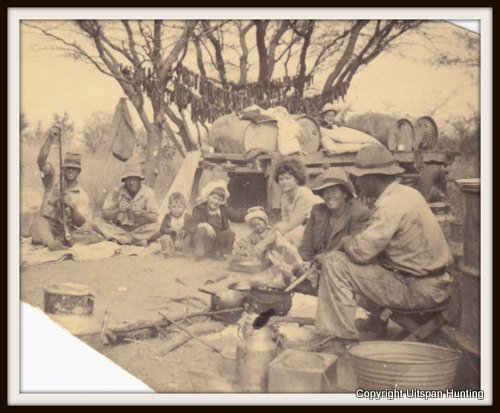
(Picture above of our ancestors.)
Did you know?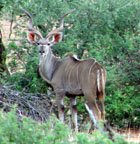 Greater Southern Kudus are famous for their ability to jump high fences. A 2 m (6.56 ft) fence is easily jumped while a 3 m (9.84 ft) high fence is jumped spontaneously. These strong jumpers are known to jump up to 3.5 m (11.48 ft) under stress. |
Did you know? Some animals have one sense more than man!The flehmen response is a particular type of curling of the upper lip in ungulates, felids and many other mammals. This action facilitates the transfer of pheromones and other scents into the vomeronasal organ, also called the Jacobson's Organ. Some animals have one sense more than man!The flehmen response is a particular type of curling of the upper lip in ungulates, felids and many other mammals. This action facilitates the transfer of pheromones and other scents into the vomeronasal organ, also called the Jacobson's Organ.This behavior allows animals to detect scents (for example from urine) of other members of their species or clues to the presence of prey. Flehming allows the animals to determine several factors, including the presence or absence of estrus, the physiological state of the animal, and how long ago the animal passed by. This particular response is recognizable in males when smelling the urine of a females in heat. |
